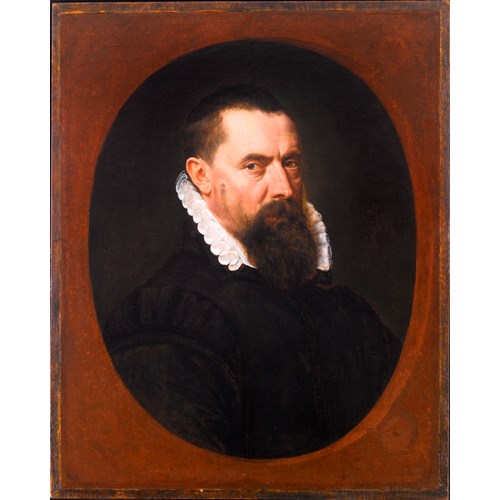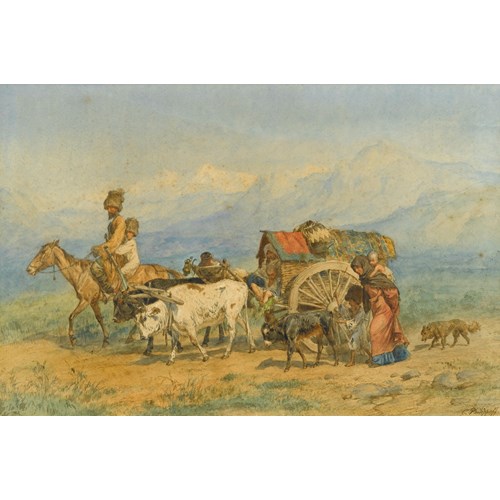Marketplace
The Return of the Prodigal Son
Jacopo Bassano
The Return of the Prodigal Son
Epoque 1400-1600, 16th Century
Origine Italy
Medium Oil on canvas
Dimension 83 x 120 cm (32⁵/₈ x 47¹/₄ inches)
The present work depicts the parable of the prodigal son told in the Gospel of Luke (15: 11-32) The story tells of a father with two sons, the younger of whom demands his inheritance while his father is still living. The son leaves for a distant land and, having spent his inheritance, is forced to become a swineherd. When he finally decides to return home to his family, his father greets him with open arms and slaughters a fatted calf in his honour. The eldest son, angered by his father’s easy forgiveness of his brother’s foolishness and the lack of reward for his own faithfulness is told, ‘Son, thou art ever with me, and all that I have is thine. It was fitting to make merry and be glad, for this your brother was dead, and is alive; he was lost, and is found’. The iconography of the prodigal son was popular in medieval and Renaissance art, particularly in the Northern Renaissance, and Rembrandt van Rijn’s (1606-1669) depiction, completed late in his life, is one of his most admired works.
This version by an artist from Jacopo Bassano’s workshop, presents the fable in two narrative registers, the exterior and interior of the father’s home. On the left, the son kneels in front of his father on the steps to the house. His hands are raised in repentance, whilst his father leans forward to bless him. The narrative then shifts to the interior of the home, and in the centre the slaughtered calf is seen hanging from the wall, its stomach slit. The interior of the house is filled with activity as the preparation for a feast is evidently underway. On the right, a lady tends a fire while another prepares a spit for roasting birds. On the left, two young children wash utensils while another man pulls items from a cupboard.
This is a simplistic, rustic treatment of a biblical theme created through the use of engrossing rural details. The dog in the right hand corner, for example, watches a basket of fish with great concentration. This painting could be described as a genre work on account of the hive of activity and realism of the figures within the home, whilst the hanging game next to the fireplace introduces a still life element. All of these characteristics complement the biblical story and add inventive, narrative elements to the parable itself.
The present work is derived from Bassano’s original, now held in the Galleria Doria Pamphilj, Rome. It is an example of a medium sized biblical picture within a genre setting, a type of collectors’ picture which Bassano is credited with inventing c. 1576-1577. Another one of the original examples is Christ in the House of Mary, Martha and Lazarus, which is composed in a comparable manner to the present work. The figures from the biblical narrative are positioned on the left-hand side and do not intrude on the detailed and engrossing kitchen scene, which is Bassano’s main focus. In Italian art of this period there was no tradition of genre scenes, and so Bassano’s inclusion of a biblical story, however small, to some extent legitimises his subject matter.
Bassano, also known as Jacopo da Ponte, was born in Bassano del Grappa outside Venice. His father Francesco Bassano the Elder (c.1475-1539) was a ‘peasant artist’ and Jacopo absorbed many of these rustic elements into his work, for example animals, farmhouses and rural landscapes. Jacopo trained under his father initially in the family workshop, though later he travelled to Venice where he worked in the studio of Bonifazio Veronese (1487-1553).
After working in Venice and other towns in the Veneto, Bassano established a workshop in his home town of Bassano del Grappa with his four sons Francesco the Younger (1549-1592), Gerolamo (1566-1621), Giovanni Battista (1553-1613), and Leandro (1557-1662). All of his sons shared his style so, as in the present work, it is often difficult to precisely identify their individual contributions. To meet the demand from his collectors, after c.1575, Jacopo had many copies of his works made by apprentices and by his sons, and The Return of the Prodigal Son is one such example.
This version by an artist from Jacopo Bassano’s workshop, presents the fable in two narrative registers, the exterior and interior of the father’s home. On the left, the son kneels in front of his father on the steps to the house. His hands are raised in repentance, whilst his father leans forward to bless him. The narrative then shifts to the interior of the home, and in the centre the slaughtered calf is seen hanging from the wall, its stomach slit. The interior of the house is filled with activity as the preparation for a feast is evidently underway. On the right, a lady tends a fire while another prepares a spit for roasting birds. On the left, two young children wash utensils while another man pulls items from a cupboard.
This is a simplistic, rustic treatment of a biblical theme created through the use of engrossing rural details. The dog in the right hand corner, for example, watches a basket of fish with great concentration. This painting could be described as a genre work on account of the hive of activity and realism of the figures within the home, whilst the hanging game next to the fireplace introduces a still life element. All of these characteristics complement the biblical story and add inventive, narrative elements to the parable itself.
The present work is derived from Bassano’s original, now held in the Galleria Doria Pamphilj, Rome. It is an example of a medium sized biblical picture within a genre setting, a type of collectors’ picture which Bassano is credited with inventing c. 1576-1577. Another one of the original examples is Christ in the House of Mary, Martha and Lazarus, which is composed in a comparable manner to the present work. The figures from the biblical narrative are positioned on the left-hand side and do not intrude on the detailed and engrossing kitchen scene, which is Bassano’s main focus. In Italian art of this period there was no tradition of genre scenes, and so Bassano’s inclusion of a biblical story, however small, to some extent legitimises his subject matter.
Bassano, also known as Jacopo da Ponte, was born in Bassano del Grappa outside Venice. His father Francesco Bassano the Elder (c.1475-1539) was a ‘peasant artist’ and Jacopo absorbed many of these rustic elements into his work, for example animals, farmhouses and rural landscapes. Jacopo trained under his father initially in the family workshop, though later he travelled to Venice where he worked in the studio of Bonifazio Veronese (1487-1553).
After working in Venice and other towns in the Veneto, Bassano established a workshop in his home town of Bassano del Grappa with his four sons Francesco the Younger (1549-1592), Gerolamo (1566-1621), Giovanni Battista (1553-1613), and Leandro (1557-1662). All of his sons shared his style so, as in the present work, it is often difficult to precisely identify their individual contributions. To meet the demand from his collectors, after c.1575, Jacopo had many copies of his works made by apprentices and by his sons, and The Return of the Prodigal Son is one such example.
Epoque: 1400-1600, 16th Century
Origine: Italy
Medium: Oil on canvas
Dimension: 83 x 120 cm (32⁵/₈ x 47¹/₄ inches)
Plus d'œuvres d'art de la Galerie









